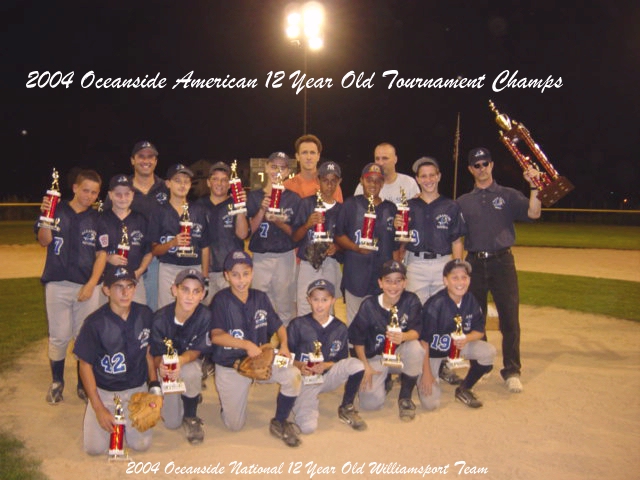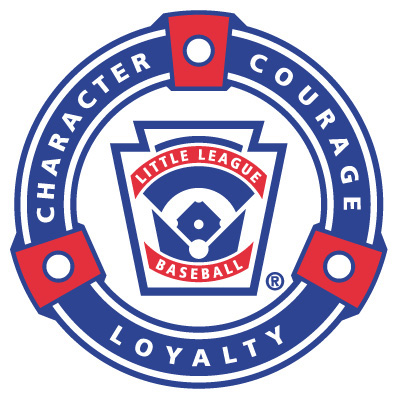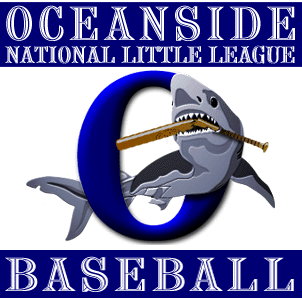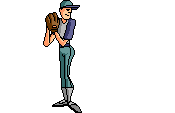News and Announcements
NATIONAL LEAGUERS WIN OALL TOURNAMENT CHAMPIONSHIP
National Leaguers Win Baseball Championship
by Bob Burns
For the first time in almost 30 years, an Oceanside 11-12 year-old Little League All-Star team has won the Oceanside American League Tournament this summer. The Oceanside National Little League squad defeated the East Meadow All-Stars, 7-4, completing a string of three upset playoff wins that included a 5-3 victory over Massapequa Coast and a 5-3 win over top-seeded Levittown.
The invitational tournament regularly attracts not only local teams like Rockville Centre and Long Beach, but a number of other Little League districts from Nassau and Queens, as well.
“This is the only time in all the years we’ve run this tournament that an Oceanside team has won the championship,” American League president George Ciociano announced when presenting the winner’s trophies.
The competition within the tournament over the decades has been so difficult that even in years when either an American League or National League team has won the District 30 championship and moved on to the Long Island championship, the American League Tournament prize proved elusive for many of those Williamsport teams.
“Since these kids were first learning to put on a glove and hold a bat, they and their parents have been pointing to and looking forward to the excitement of the Williamsport Little League Tournament play and the American League Tournament that follows,” says the manager of the championship team, Bob Burns. “They set a goal to win the local district and dream of something bigger,” Burns adds. But the team of 12 year-olds lost their bid to be crowned the best in the district that includes 10 towns stretching from Long Beach to Freeport on the South Shore.
The National Leaguers had a disappointing 5-4 loss in extra innings to Freeport, the eventual District 30 Champions. It was followed by an elimination loss to Lynbrook in which two of the Oceanside teams best players were injured.
“We were left with a feeling that we had under-achieved and that the American League tournament would be our opportunity for the kids to show their talent and character,” Burns notes.
Both attributes were on full display in last Tuesday night’s game, when Jordan Gilman struck out two East Meadow batters with the bases loaded in the bottom of the fifth inning, to end the threat and leaving Oceanside with a 5-4 lead. East Meadow threatened again in the last inning, loading the bases, but Gilman’s last fastball was hit weakly to first base when lefty Danny Frisch gloved it and outraced the batter to the bag.
The contest was marked by strong hitting on both sides but overshadowed by great defensive plays that made all the difference. No play was bigger than right fielder A. J. Longo’s back- hand over the shoulder grab of a liner in the sixth inning with no out and a runner on first.
The East Meadow player was already more than half way to second when Longo snared what looked like a sure gapper. The righty seventh grader whirled to his glove side and threw a strike to first for an all -important double play. It was a similar catch to the one he made in the fifth but the throw not in time to double up the runner that time.
Second basemen Joe Totino, who hit a run scoring double early in the game, came up big on defense in the fourth as East Meadow was whittling away at Oceanside’s 5-1 lead. A liner with the bags full appeared headed for right field. But Totino timed his leap perfectly, barely snatching the hard shot, and doubling up the runner at first. Three batters and two runs later, another run saving play was made by Joe Gallub, who had started the game on the hill and was the winning pitcher. Relieved of his pitching duties and moved to centerfield Gallub aggressively charged a line shot up the middle with the bags full of central Nassau residents.
Taking the lined ball on one hop, Gallub uncorked a liner of his own, throwing yet another strike to the plate. Catcher Corey Densing stepped up in front of the dish, catching the ball waist high and then dove for the third base side of the plate, landing atop the East Meadow player hell bent to score. The umpire raised his hand to signal the call as Densing, on his stomach, arched his back and raised his mitt to show he still had the ball. The out call was completed and the Oceanside “Sharks” swarmed both thrower and catcher for getting them out of troubled waters and still holding a 5-3 lead.
“If ever there was a “team” victory in baseball, this was it,” Burns commented. Thirteen of the squad’s 14 players reached base safely. Andrew Grann, Densing and Gallub had two hits each in the 16- hit effort.
The champs posted 5 runs in the second inning with Totino, Scott Davis, Matt Kambic, Justin D’Angelo and Densing crossing home. Kambic, Densing and Gallub had big RBI shots. When East Meadow whittled the lead down to one in the fifth, the “Sharks” retaliated with two insurance runs in the top half of the sixth, giving reliever Gilman (42) some breathing room.
Totino got the rally going with a leadoff walk. With one out, third sacker Ben Schneid singled to center. Both runners then moved up a base on a wild pitch. The lefty swinging Frisch then dropped a soft liner down the left field line scoring Totino. With two out Grann beat out an infield chopper, scoring Frisch.
“Those two runs took a lot of pressure off myself and our two coaches—Bruce Gallub and Jeff Grann- knowing that it would take a bases loaded home run to beat us in the bottom of the sixth,” Burns concluded.
ROAD TO THE CHAMPIONSHIP: The following are brief summaries of the Oceanside National team’s path to victory.
Division Championship Game Vs Massapequa Coast: On Sept. 4 pitcher Danny Frisch posted his fourth win of the tournament for the “Sharks” (6-2 team record, overall) pitching an overpowering five innings before being relieved by Scott Davis in the sixth, who closed the deal.
Frisch struck out eight batters including the side in the second, getting the four, five and six hitters in order. His 5-hitter’s only blemish in the 5-2 win was a hit batter followed by a home run in the bottom of the fourth. His ERA for All-Star play this summer was an outstanding 1.36 per nine innings.
The offensive output for the National Leaguers began in the third as Frisch and James Grossi got key hits to put up the first score. The “Sharks” added three big runs the following inning. Mike Connell singled and Nick Martinez walked with no one out. With one out and runners on second and third, Totino delivered a shot to score both. Frisch followed with a walk, moving Totino to third. The speedy infielder then scored on a wild pitch. The winners added a run with two outs in the sixth on Matt Kambic’s RBI single to left, scoring Martinez, who had singled as well. The upset win reversed a 5-0 loss to Massapequa earlier in the tournament.
Division Semi-Final Game vs Levittown: On August 27th, the National League squared off against 2nd seed Levittown, which had bested them 3-1 in regular tournament play. This time, when it mattered more, the “Sharks” bats came alive for 5 runs, supporting the 4-hit, 6-strike out performance of Joe Gallub, who went five innings for the W. Nick Martinez mopped up getting glove help from Ben Schneid who snared a liner at second and doubled off the runner at first for the final out of the game. The hitting stars of the game included Andrew Grann (3-3 with 2RBI), Mike Connell (1-3, 2 Runs), and Gallub (2-3, 2b, Run). Corey Densing and Scott Davis each contributed a single and an RBI.
The Oceanside team locked its playoff spot with a 4-0 win over Long Beach, Danny Frisch throwing the shutout. Danny also had a victory over the East Meadow B team and Hollis/Queens Village.
In all levels of Summer Tournament play, Oceanside National compiled a 10-6 record with a team batting average of .292 and a pitching staff ERA of 3.35 per nine innings. It scored 76 runs while giving up 56, underscoring the importance of good pitching and defense to win tightly played games against very good opponents.

Little League Statement on non-Wood Bats


Little League Implements New Rule to Protect Pitchers’ Arms

